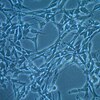Ad5/48 hexon oncolytic virus expressing sTGFβRIIFc produces reduced hepatic and systemic toxicities and inhibits prostate cancer bone metastases.
Xu, W; Zhang, Z; Yang, Y; Hu, Z; Wang, CH; Morgan, M; Wu, Y; Hutten, R; Xiao, X; Stock, S; Guise, T; Prabhakar, BS; Brendler, C; Seth, P
Molecular therapy : the journal of the American Society of Gene Therapy
22
1504-17
2014
Zobrazit abstrakt
We are interested in developing oncolytic adenoviruses for the treatment of prostate cancer (PCa) bone metastases. A key limitation of Adenovirus 5 (Ad5) is that upon systemic administration, it produces major liver and systemic toxicities. To address this issue, a chimaeric Ad5/48 adenovirus mHAd.sTβRFc was created. Seven hypervariable regions of Ad5 hexon present in Ad5-based Ad.sTβRFc expressing soluble transforming growth factor beta receptor II-Fc fusion protein (sTGβRIIFc), were replaced by those of Ad48. mHAd.sTβRFc, like Ad.sTβRFc, was replication competent in the human PCa cells, and produced high levels of sTGβRIIFc expression. Compared to Ad.sTβRFc, the systemic delivery of mHAd.sTβRFc in nude mice resulted in much reduced systemic toxicity, and reduced liver sequestration. Ad.sTβRFc produced significant liver necrosis, and increases in alanine transaminase, aspartate transaminase, lactate dehydrogenase, tumor necrosis factor-α, and interleukin-6 levels, while mHAd.sTβRFc produced much reduced responses of these markers. Intravenous delivery of Ad.sTβRFc or mHAd.sTβRFc (5 × 10(10) viral particles/mouse) in nude mice bearing PC-3-luc PCa bone metastases produced inhibition of bone metastases. Moreover, a larger dose of the mHAd.sTβRFc (4 × 10(11) viral particles /mouse) was also effective in inhibiting bone metastases. Thus, mHAd.sTβRFc could be developed for the treatment of PCa bone metastases. | 24791939
 |
The contributions of microtubule stability and dynamic instability to adenovirus nuclear localization efficiency.
James C Warren,Lynne Cassimeris
Cell motility and the cytoskeleton
64
2007
Zobrazit abstrakt
Adenoviruses (Ads) utilize host cell microtubules to traverse the intracellular space and reach the nucleus in a highly efficient manner. Previous studies have shown that Ad infection promotes the formation of stable, posttranslationally modified microtubules by a RhoA-dependent mechanism. Ad infection also shifts key parameters of microtubule dynamic instability by a Rac1-dependent mechanism, resulting in microtubules with lower catastrophe frequencies, persistent growth phases, and a bias toward net growth compared to microtubules in uninfected cells. Until now it was unclear whether changes in RhoGTPase activity or microtubule dynamics had a direct impact on the efficiency of Ad microtubule-dependent nuclear localization. Here we have performed synchronous Ad infections and utilized confocal microscopy to analyze the individual contributions of RhoA activation, Rac1 activation, microtubule stability, dynamic behavior, and posttranslational modifications on Ad nuclear localization efficiency (NLE). We found that drug-induced suppression of microtubule dynamics impaired Ad NLE by disrupting the radial organization of the microtubule array. When the microtubule array was maintained, the suppression or enhancement of microtubule turnover did not significantly affect Ad NLE. Furthermore, RhoA activation or the formation of acetylated microtubules did not enhance Ad NLE. In contrast, active Rac1 was required for efficient Ad nuclear localization. Because Rac1 mediates persistent growth of microtubules to the lamellar regions of cells, we propose that Ad-induced activation of Rac1 enhances the ability of microtubules to search and capture incoming virus particles. | 17565754
 |
Infection with replication-deficient adenovirus induces changes in the dynamic instability of host cell microtubules.
Warren, JC; Rutkowski, A; Cassimeris, L
Molecular biology of the cell
17
3557-68
2005
Zobrazit abstrakt
Adenovirus translocation to the nucleus occurs through a well characterized minus end-directed transport along microtubules. Here, we show that the adenovirus infection process has a significant impact on the stability and dynamic behavior of host cell microtubules. Adenovirus-infected cells had elevated levels of acetylated and detyrosinated microtubules compared with uninfected cells. The accumulation of modified microtubules within adenovirus-infected cells required active RhoA. Adenovirus-induced changes in microtubule dynamics were characterized at the centrosome and at the cell periphery in living cells. Adenovirus infection resulted in a transient enhancement of centrosomal microtubule nucleation frequency. At the periphery of adenovirus-infected cells, the dynamic instability of microtubules plus ends shifted toward net growth, compared with the nearly balanced growth and shortening observed in uninfected cells. In infected cells, microtubules spent more time in growth, less time in shortening, and underwent catastrophes less frequently compared with those in uninfected cells. Drug-induced inhibition of Rac1 prevented most of these virus-induced shifts in microtubule dynamic instability. These results demonstrate that adenovirus infection induces a significant stabilizing effect on host cell microtubule dynamics, which involve, but are not limited to, the activation of the RhoGTPases RhoA and Rac1. Celý text článku | 16775012
 |
Rapid detection and serotyping of adenovirus by direct immunofluorescence.
Wood, S R, et al.
J. Med. Virol., 51: 198-201 (1997)
1997
Zobrazit abstrakt
Four fluorescent antibody reagents were evaluated for their suitability for the identification of adenovirus isolates by immunofluorescence. The antibodies used in the reagents consist of monoclonal antibodies against adenovirus type 3 (Ad3), Ad4, Ad8, and adenoviruses of subgroup C (Ad1,2,5,6), serotypes known to occur in outbreaks of disease. Most of the monoclonal antibodies employed were reactive against type-specific antigens found on the hexon protein. Reagents employing two noncompeting anti-hexon antibodies were more sensitive than reagents prepared with only one monoclonal antibody, although both types of reagents exhibited a high degree of specificity. Five hundred and seventeen adenovirus isolates (359 of which had previously been typed by other methods) and 46 nonadenovirus isolates were examined with all four type-specific reagents in parallel with an adenovirus group-specific reagent. The results indicate that direct typing of adenovirus isolates is feasible, leading to significant savings in time compared to other typing methods and should contribute to the management of certain adenovirus infections, particularly during outbreaks. | 9139083
 |
















